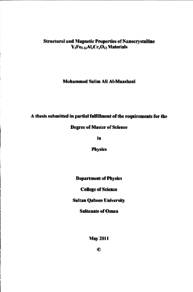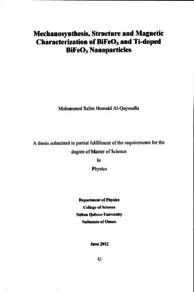Document
Structural and magnetic properties of nanocrystalline Y3Fe5-2xAlCr012 materials
Publisher
جامعة السلطان قابوس
Gregorian
2011
Language
English
English abstract
Single-phased nanocrystalline Y3Fe5-2.,Al,Cr,012 materials with x = 0.0, 0.2, 0.4 and 0.6 have been prepared by the conventional ceramic technique at 1200°C using a stoichiometric mixture of the starting materials Y203, Fe2O3, Al2O3 and Cr203, followed by ball milling for 1, 3 and 5 hours to produce nanosized samples. Energy dispersive X-ray spectroscopy (EDXS) using scanning electron microscope shows that the weight percentages of the Y and O atoms are consistent within 2% accuracy. TEM shows that we have distributions in the particle sizes between 20 and 300 nm, small particles agglomerate as Alt/Cr* co-doping increases. On increasing the milling duration, the large particles were pulverized; hence numbers of small particles increased as well as aggregation. PowderCell analyses of X-ray diffraction patterns of the samples show them to crystallize in the (la3d) space group and the corresponding lattice constant decreases with increasing Al" and Cr* contents (x). The average crystallite size ranges between 24 and 36 nm for all samples during milling. XRD spectra reveal that for the milling time of 3 hours, the rare-earth garnet YIG starts to decompose into the perovskite Y FeO3 and hematite a-Fe2O3. The Fe Mössbauer measurements at 295 and 78 K show a superposition of two magnetic sextets and a paramagnetic doublet; this doublet shows some reduction in intensity with decrease in the temperature. The existence of the doublet at 78 K suggests that the blocking temperature is less than LN temperature. From the intensity of the Fert sites and assumed site occupancies of the Cr* and Al" ions, it may be deduced that the paramagnetic doublet is associated with both octahedral and tetrahedral sites. The hyperfine fields for the octahedral and tetrahedral sites are reduced by milling. The 300 and 113 K magnetization measurements for the samples ball-milled for 1 and 5 hours show similar trend decrease for the magnetization with co-doping and milling; saturation magnetization monotonically decrease with increasing x. The reduction in particle sizes for 5-hour milled samples may cause the sharp decrease in magnetization. Néel temperature (TN) does not change with milling, but it decreases with increasing concentration (x). This implies that the magnetic super-exchange interactions between the Fe + ions at different sites (octahedral and tetrahedral) were not affected by milling.
Member of
Resource URL
Arabic abstract
تم تحضير الجسيمات النانومترية البلورية أحادية الطور للمواد Y3 Fes - 2 Al , Cr012 بتراكيز مختلفة y = 0 . 2 , 0 . 0 , 0 . 4 و 0 . 6 بالطريقة الخزفية التقليدية للخليط المولي المكافيء لكل من ,Y03 Fe2O3 , Al2O3 , Cr20 عند درجة حرارة 1200 مئوية, متبوعا بالطحن لفترات زمنية مختلفة (ساعة واحدة ثلاث ساعات , خمس ساعات). أوضح مطياف تبدد طاقة الأشعة السينية (EDXS) - وذلك باستخدام جهاز الماسح الإلكتروني - بأن النسبة المئوية لعنصري اليتريوم (Y), والأوكسيجين (0) ثابتة ومتوافقة مع النسب النظرية مع نسبة خطأ %2. أظهر جهاز المجهر الإلكتروني (TEM) أن توزيع في أحجام الجسيمات النانوية يتراوح بين 20 و 300 نانومتر, حيث تتجمع الجسيمات الصغيرة مع بعضها بزيادة تركيز الألمنيوم والكروم. ومع زيادة فترة الطحن تسحق الجسيمات الكبيرة إلى جسيمات صغيرة, وبالتالي فإن عدد هذه الجسيمات يزيد مع زيادة فترة الطحن. تحاليل برنامج (PowderCell) للنماذج الناتجة عن حيود الأشعة السينية لجميع العينات, بينت أنها تنتمي إلى المجموعة البلورية (la3d) وأن زيادة تركيز الألمنيوم والكروم (x) تكون مصحوبة يتناقص في حجم وحدة الخلية. وجدنا بأن متوسط الحجم البلوري يتراوح بين 24 و 36 نانومتر لكل العينات خلال الفترات الزمنية المختلفة للطحن. أيضا وجد أنه بعد 3 ساعات من الطحن فأن العينات تبدأ في التحلل إلى مركبات البروفسکایت ,YFe0 والهيماتایت Fe2O3-. أظهرت نتائج مطياف الماسباور للنظير 57Fe عند درجات الحرارة 295 كلفن و 78 كلفن وجود تراكب بين اثنين من التفاعلات المغناطيسية فائقة الدقة بالإضافة إلى تفاعل بارامغناطيسي في كل العينات الذي يقل مع إنخفاض درجة الحرارة. وجود التفاعل البار مغناطيسي في درجات حرارة منخفضة يثبت أن درجة الحرارة المانعة لهذه المواد أقل من 78 كلفن. عن طريق حساب النسب المئوية لأيونات الحديد مع افتراض المواقع المفضلة لأيونات الألمنيوم والكروم, تم الاستنتاج بأن هذا التفاعل البارمغناطيسي يمكن أن يعزى لكل من موقعين أيونات الحديد : الموقع ثماني الأوجه (octahedral) والموقع رباعي الأوجه (tetrahedral). هذه التفاعلات المغناطيسية فائقة الدقة تنخفض مع زيادة ساعات الطحن. أظهرت القياسات المغناطيسية عند درجتي الحرارة 300 كلفن و 113 كلفن لكل من العينات المطحونة الفترة ساعة واحدة و 5 ساعات نفس السلوك في التناقص مع زيادة التركيز وزيادة فترات الطحن. إن إنخفاض التأثر بالمغناطيسية للعينات المطحونة لفترة 5 ساعات يعزى إلى تناقص في حجم الجسيمات. وجد أن درجات الحرارة المانعة للتأثر بالمغناطيسية (درجات حرارة نيل - TN) لاتتغير مع زيادة الطحن, لكنها تتناقص مع زيادة تركيز الألمنيوم والكروم, وهذا يعكس أن التفاعل الخاص بين مواقع أيونات الحديد لا يتأثر بالطحن.
Category
Theses and Dissertations


